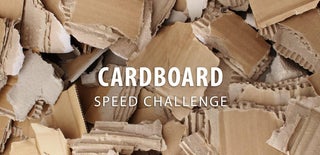Introduction: Cardboard Model Mark IV British Tank
The Mark IV British tank was the backbone of Allied advances in World War I, capable of striking fear in the hearts of trenched German soldiers, as it advanced at a mighty 3 mph. I made this model about ten inches long, much smaller than the 26 foot iron bound tank.
Supplies
Hobby knife
Rubber bands
Ruler
Pen
Scissors
School glue
Cardboard boxes, tubes, and other random pieces
Pictures from the side, top, front and back. You will base your tank off these.
Optional: airbrush, paint, paintbrushes
Step 1: Making the Tracks
I drew out the a grid across the main picture, which I used to base to tank off of. From this, I made a bigger grid on a large piece of cardboard, and used a transition of centimeters to inches, which I figured out when I printed the pictures. I drew out a copy of the track bases on the squares, with the same preportions as the printed picture. I traced the first cutout of the track base and cut out about ten copies (with one ply cardboard), five for each track. I glued these together and used rubber bands to keep them even.
Next: the tracks themselves. I used one ply cardoard, ripped off one side of the cover, and then cleaned the ridges with light sandpaper. Using measurements from my printed pages, I carefully cut out the tracks. Then I took the laminated track bases and glued the tracks over them, again using rubber bands to hold them on.
Step 2: Making the Hull
As I did before, I drew a grid over a top view of the tank in centimeters, and converted it to inches. I drew a picture of the top of the hull using the grid on the cardboard. I traced it several times, and laminated the layers into a block, almost three inches tall. I then used a hobby knife to cut the shape of the hull to the proper dimensions. I plated every surface with a thin layer of shoebox cardboard, and glued it, holding it together with rubber bands while it glued. Note that I added details later.
Step 3: Making the Machine Gun and Cannon Barrels
For the basic machine gun barrels, I rolled up short sections of cardboard tube and glued them. I used a thick, cardboard straw-like piece to craft the two cannons, but I could have rolled them with cardboard tube like the machine guns.
Step 4: Adding Life to the Chassis
I added some extra detail, which are shown above in the pictures. I glued on all the different flaps, hatches, and grills necessary for a tank model. I also made the unditching beam and stained it, as well as the side chassis rails, all to perfect perportion on the tank.
Step 5: Making Exhaust System
I made the exterior exhaust system using a small piece of wire and paper. I coated a large section of paper with school glue, and rolled it up with the wire. Using a marker, I then colored it brown to match the tank. You can see in the photos that I used some rolled cardboard to run the exhast out the back of the tank.
Step 6: Crafting the Side Sponsons
Using the cannons I made before, I started crafting the sponsons. I wanted to make the turrets rotate, so I used a circular middle. I then built the sponson around the turret. Note that you have to make two of these.
Step 7: Poking "Rivets" in Everything
I used a pin to poke holes at regular intervals, then drew along them, which gave the effect of bolted metal when I painted it.
Step 8: Painting the Tank
Using an airbrush, I painted (with mixed and thinned house paint) all five of the separate pieces. I painted three layers. The original Mark IV tank was usually brown or olive.
Step 9: Gluing It All Together
I forgot to take a picture for this section, but this step is very elementary. I simply used my grid (again) to estimate the right spacing for all the pieces before glueing them together.
Step 10: Final Details
I then painted on the identification markings and numbers, and added the beam and rails. I used some coarse twine to hold the beam on, but yarn would have worked.
And now, its complete!

Participated in the
Cardboard Speed Challenge













